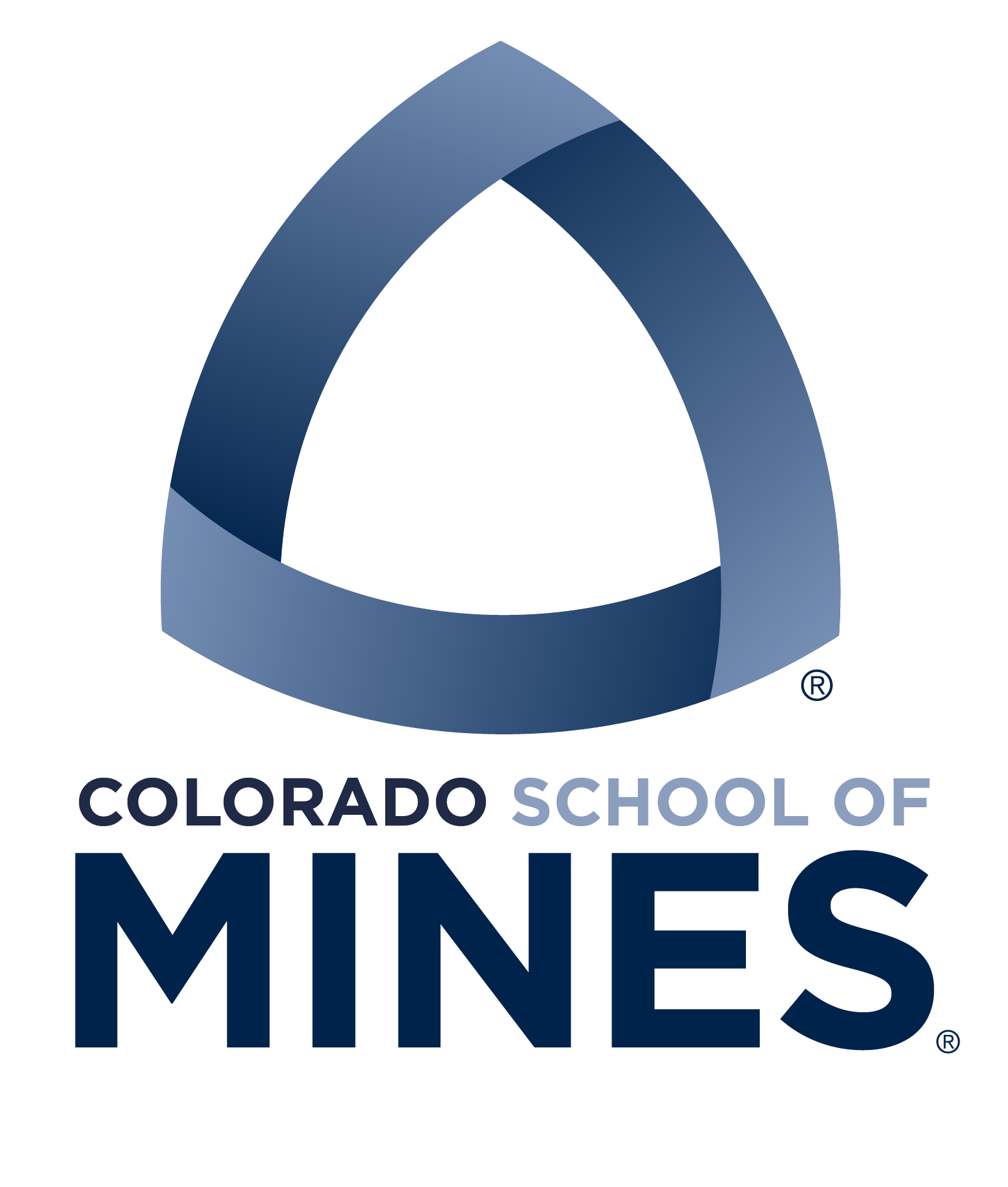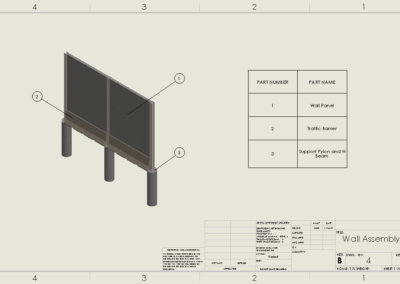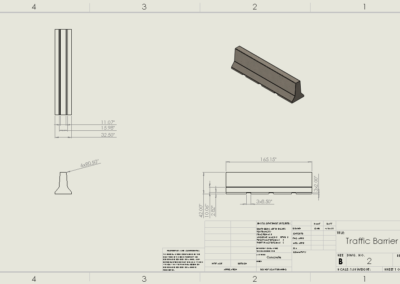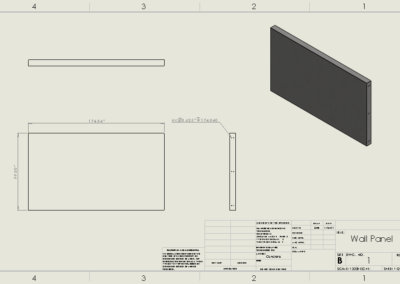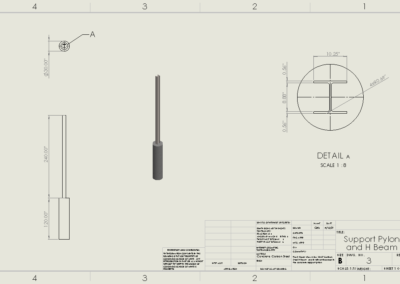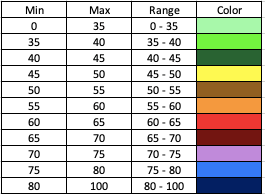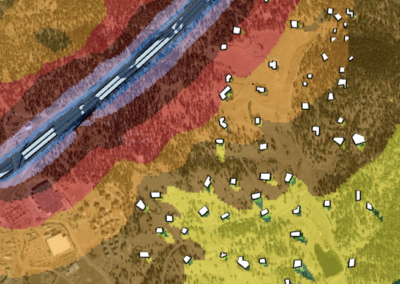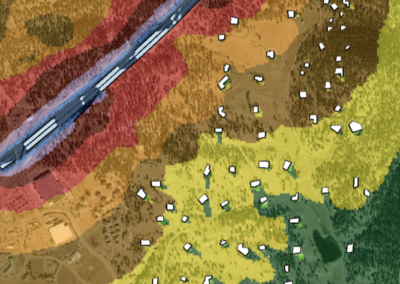Spring Ranch I-70 Noise Abatement
Overview
The Spring Ranch neighborhood is located in Golden, Colorado south of exit 253 of I-70. The traffic volume of I-70 along the mountain corridor between Genesee Park (exit 254) and Evergreen Parkway (exit 252) has increased over 73% from 1991 to 2019. An increase in traffic volume has created an additional increase in noise pollution in the area.
Melanie and Ed Westergaard represented their neighborhood homeowner’s association (HOA) to sponsor our team to create an effective noise abatement system that would decrease noise pollution in the Spring Ranch study area by at least five decibels. The project is significant because it is intended to benefit all people and animals, including wildlife and pets, residing in the affected area.
The solution to the noise pollution our team decided on was to design a noise wall made of concrete along I-70. A noise wall was found to be cost effective, timely, and the most feasible concept to create a design for. Concrete was the chosen material for the wall due to its effective noise reflection and absorption abilities. Our design incorporates Jersey barriers to replace the existing metal guard rails in the planned location of the wall, pre-cast concrete panels that will be placed atop the Jersey barriers, and steel H sections to hold the concrete panels in place.
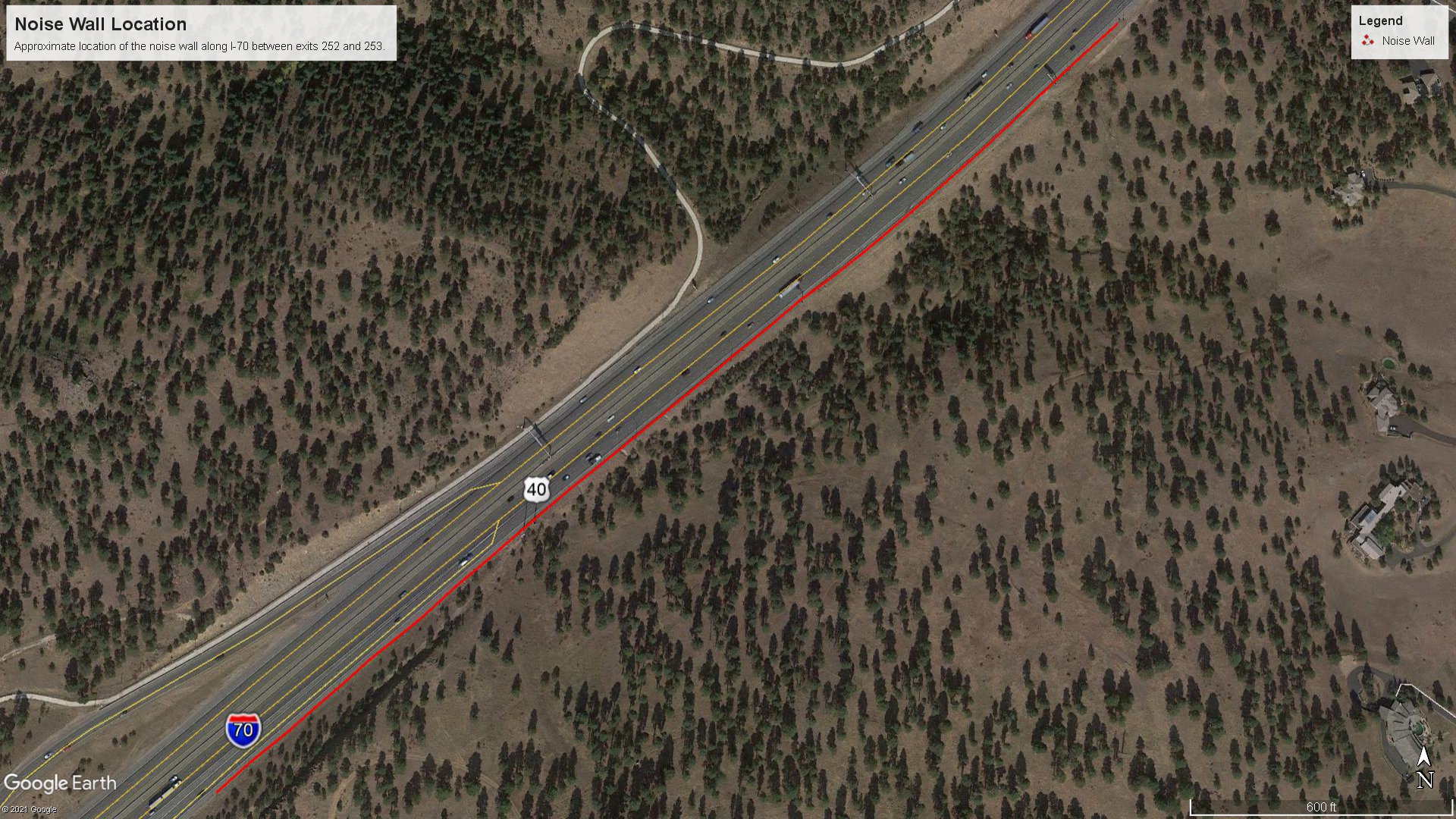
Live Zoom Chat
Use the link below to join us live from 8:00 – 10:30 a.m. on April 29th.
Please use passcode: 382656
Or iPhone one-tap: 13462487799,92917586465# or 16699006833,92917586465#
Or Telephone:
Dial: 346 248 7799 (US Toll) or 669 900 6833 (US Toll)
Meeting ID: 929 1758 6465
Team Members
- Reece Hall
- Tre Labossiere
- Helena Lawrence
- Samantha Lopez
- Claire McGahern
- Jesse Orris
The Client
- Melanie and Ed Westergaard
Acknowledgements
Project Advisors: Alina Handorean and Elizabeth Reddy
Technical Advisors: Andres Guerra and Matt Whitney
Donations Made by: Spring Ranch HOA
Video
Elevator Pitch
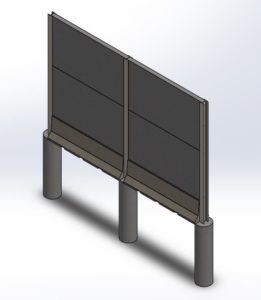
The purpose of the sound wall is to create a barrier between the noise pollution coming off of Interstate 70 and the residents of the Spring Ranch community. The wall was designed to be installed in individual concrete sections in order to make the construction process as noninvasive as possible. The stakeholders of the project include the Colorado Department of Transportation (CDOT), the Spring Ranch residents, and I-70 commuters. In designing the wall, all significant force calculations were carried out to in order minimize any possible risks for the proposed wall design. This design provides a fair solution for each stakeholder, most importantly providing a significant amount of noise reduction to the Spring Ranch neighborhood.
Using Noise3D, a 3-dimensional noise simulation program, the Spring Ranch Neighborhood, I-70, and the sound wall were modeled. The model with no sound wall implemented matched the sound intensity levels of measurements taken by the team at the beginning of the design process, confirming that the program was accurate. At present day traffic volume values, a 20 ft. sound wall reduced the average sound intensity level by 4.28 dB, below the CDOT requirement of at least 5 dB of sound reduction. Traffic volume data pulled from a CDOT database allowed for future projections of highway noise levels, which are expected to increase at a steady rate, as the population of Colorado continues to increase. Starting in the year 2040, the 20 ft. sound wall would be considered effective under CDOT code, as it results in an average of 5.10 dB in sound intensity level reduction.
Design Approach
The team formulated four relevant and practiced noise mitigation techniques with a pros and cons list from the preliminary design report and placed them into a design matrix to compare their capabilities against each other. The four concepts included a conventional noise wall, earthen berm, private residential wall, and a vegetation wall. The list was aided by preliminary design drawings of how each design would look based on previous designs in practice today. The pros and cons list encompassed what each individual concept does well and poor with in respect to the other designs.
The design matrix took into account cost, stakeholder support, construction time, feasibility, performance, environmental impacts, and the effects that it would have on I-70 traffic. Each design was given a score with 0 being the worst and 5 being the best. Then the design with the highest score would be designed. The Earthen berm received the lowest score out of all of the designs due to the lack of applicability for it through our site. The interstate (I-70) is not on level ground throughout this area and would need a significant amount of material to be built up.
The environmental impacts were then taken into consideration by entering the highest scoring design into the envision spreadsheet. As long as the design does not completely put the environment in harm it will be considered. The envision spreadsheet was broken out into five categories which were quality of life, leadership, resource allocation, natural world, and climate.
The conventional design wall was ultimately chosen for our final design due to the high score it got on the design matrix and as well as its performance in the envision matrix. It is the most popular design method for mitigation sound in Colorado because of the rapidly changing terrain.
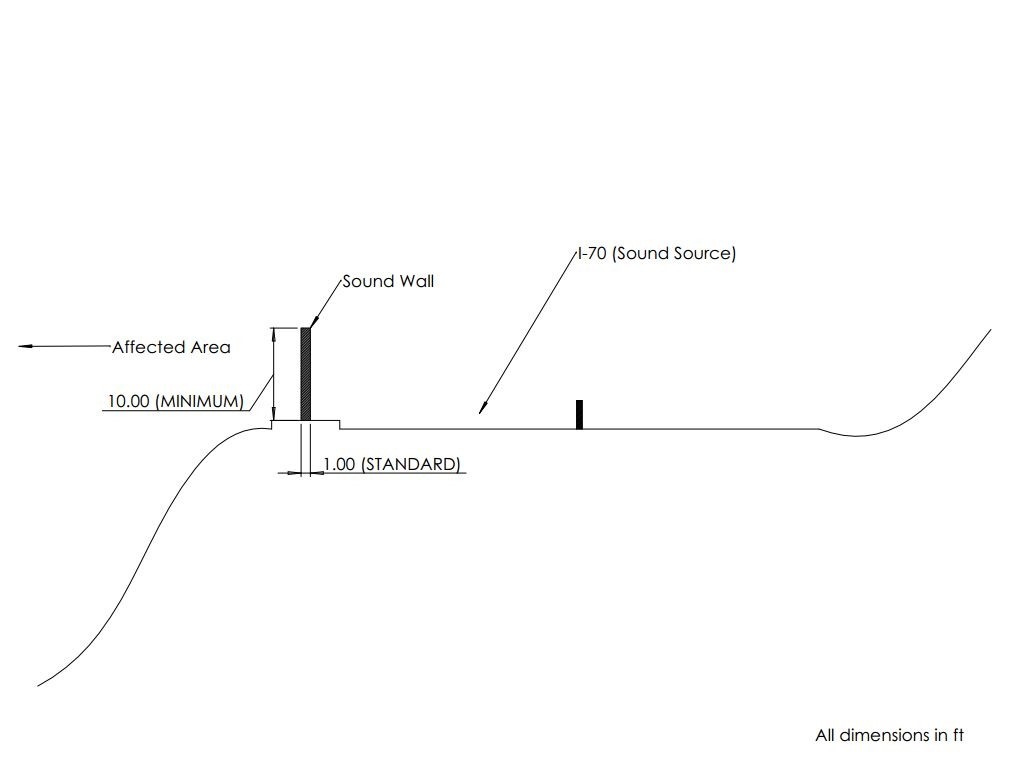
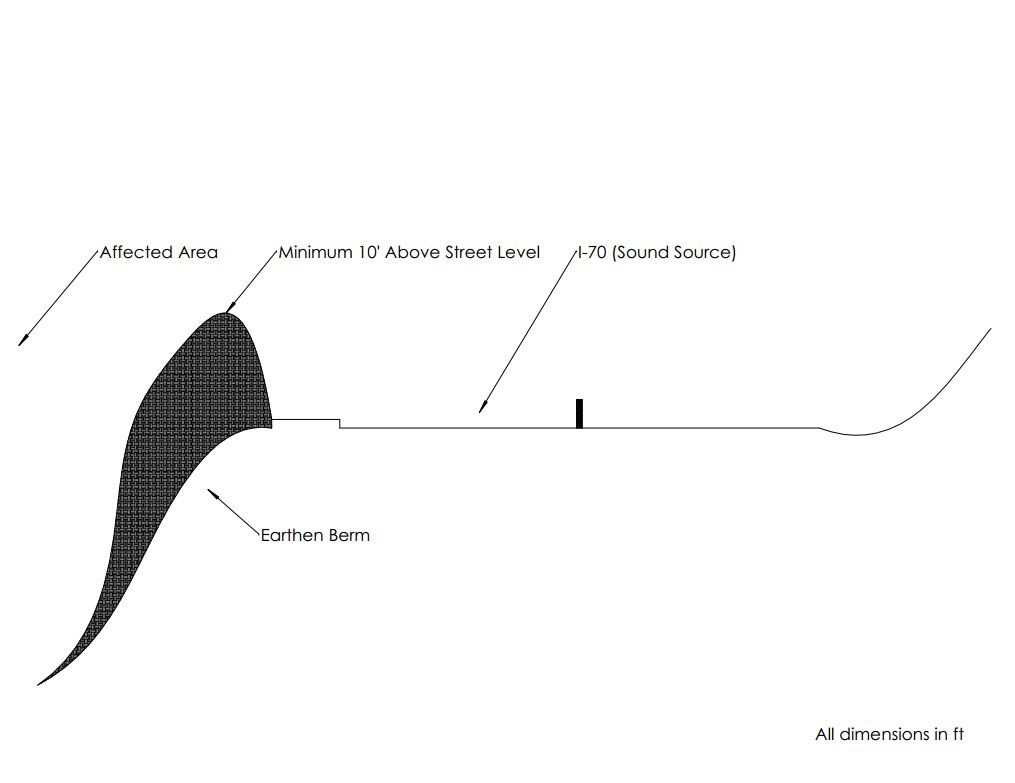
Design Solution
The clients requested a reasonable solution to the excess sound pollution coming from I-70, the adjacent interstate to the Spring Ranch community. The team met with the project client a number of times to discuss their wants and needs for the design of the sound wall. More so than the immediate benefits of the sound wall, the client was enthusiastic about the future projections of the effectiveness of the sound wall against the increase in traffic on the interstate.
Some concerns that were mentioned by the client include the restrictions of the sound wall construction along I-70 due to the location of Spring Ranch. The neighborhood is accessed via a direct exit from the highway, therefore posing design restrictions that prevent a wall from being built along some of the loudest and closest sections of the interstate. Despite this obstacle, the wall design proposed is still projected to provide noise pollution mitigation for a majority of the properties in the area.
The main area of concern of our project is that the simulated wall in Noise3D provides only the minimum amount of sound reduction upon immediate implementation. Our minimum goal was to block five decibels of sound from the Spring Ranch community, and for current day traffic volumes, the wall would not reach the 5 dB reduction goal. The average decibel reduction with the implementation of a 20 foot sound barrier is 4.28 dB, which is 0.72 dB less than the required 5 dB that CDOT requires for a sound wall to be installed. This average value was the result of a number of samples taken throughout the Spring Ranch Community, and it should be noted that the homes farthest from the interstate already experience lower noise pollution levels than the homes that are adjacent to the highway. The sound wall will have a more significant effect on the homes closest to the highway that already experience the highest sound pressure levels. Additionally, the benefits of the sound wall will increase over time as the traffic increases on the interstate. Starting around the year 2040, using the projected highway volume data, the wall would surpass the 5 dB sound reduction limit and would be a feasible method to mitigate the sound emitted from I-70 into the Spring Ranch Neighborhood.
The final design of the wall incorporated three sections: The traffic, or “Jersey” barrier, two identical cement panels stacked vertically, and a steel H section cast into a cement pylon. The wall is designed to be easily mass produced, therefore have a streamlined and smooth integration.
Next Steps
This project could move forward by continuing to analyze the effectiveness of the sound wall in different software programs. Initially, two noise modelling software programs were going to be used and compared. This would have given us a more accurate idea of how much sound would be reduced by the noise wall. In the end, only one program was used (Noise3D). Since our designed noise wall did not reduce the sound as much as the group expected, it would be interesting to see if another software had a different result. If other software programs had similar results, another solution could then be considered.
Individual noise walls were one of the solutions mentioned in the preliminary design report, and should still be considered as viable solutions for residents that would like a shorter term solution.
Additionally, it has been discussed with our client that it would not hurt to take our current findings to CDOT to see if they think our current solution is feasible.
Meet the Team
Reece Hall
 Reece is majoring in Mechanical Engineering with a minor in Computer Science, graduating May of 2021. Reece is looking to go into a career focused on automation within the renewable energy field. Outside of school, he works at a bagel/pizza shop in Golden, and enjoys hanging out with his friends and going skiing.
Reece is majoring in Mechanical Engineering with a minor in Computer Science, graduating May of 2021. Reece is looking to go into a career focused on automation within the renewable energy field. Outside of school, he works at a bagel/pizza shop in Golden, and enjoys hanging out with his friends and going skiing.
Tre Labossiere
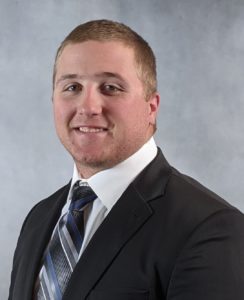 Tre is majoring in Civil Engineering and is graduating May of 2021. Tre was born and raised on a farm where building and designing buildings became a passion of his. Tre is moving to Sheridan, WY to work for Morrison-Mairle in Land Development. Tre enjoys sports, outdoors activities such as hiking, hunting, snowboarding, and kayaking.
Tre is majoring in Civil Engineering and is graduating May of 2021. Tre was born and raised on a farm where building and designing buildings became a passion of his. Tre is moving to Sheridan, WY to work for Morrison-Mairle in Land Development. Tre enjoys sports, outdoors activities such as hiking, hunting, snowboarding, and kayaking.
Helena Lawrence
 Helena is majoring in Civil Engineering and is graduating May of 2021. After graduation, she will join Kiewit full time in their Bridge and Marine District. She has completed two internships with Balfour Beatty US where she worked on various rail projects. Outside of school, Helena enjoys traveling and hanging out with friends and family.
Helena is majoring in Civil Engineering and is graduating May of 2021. After graduation, she will join Kiewit full time in their Bridge and Marine District. She has completed two internships with Balfour Beatty US where she worked on various rail projects. Outside of school, Helena enjoys traveling and hanging out with friends and family.
Samantha Lopez
 Samantha is a senior graduating in May 2021 with a B.S. in Civil Engineering. Samantha is currently a TA for the soil mechanics course. She was previously an undergraduate research assistant in underground construction and tunneling, and was an IA for the soil mechanics lab. Samantha is aiming to be hired in the transportation industry post-graduation because she wants to help make the roads in Colorado more efficient and safer for the community. Outside of work and school, Samantha enjoys cooking, road trips, building furniture, and listening to music.
Samantha is a senior graduating in May 2021 with a B.S. in Civil Engineering. Samantha is currently a TA for the soil mechanics course. She was previously an undergraduate research assistant in underground construction and tunneling, and was an IA for the soil mechanics lab. Samantha is aiming to be hired in the transportation industry post-graduation because she wants to help make the roads in Colorado more efficient and safer for the community. Outside of work and school, Samantha enjoys cooking, road trips, building furniture, and listening to music.
Claire McGahern
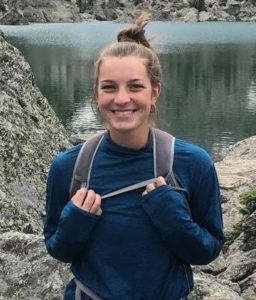 Claire is a senior in Mechanical Engineering, graduating in May, 2021. Claire is looking for a career in energy and renewables, specifically in the building infrastructure industry. Growing up in Olympia Washington, Claire participated in organizations that advocated for environmental protection and energy efficiency, and has always held goals to make a positive impact on the planet. Outside of engineering, Claire enjoys baking, climbing, skiing and picking up new hobbies, which most recently has been crocheting!
Claire is a senior in Mechanical Engineering, graduating in May, 2021. Claire is looking for a career in energy and renewables, specifically in the building infrastructure industry. Growing up in Olympia Washington, Claire participated in organizations that advocated for environmental protection and energy efficiency, and has always held goals to make a positive impact on the planet. Outside of engineering, Claire enjoys baking, climbing, skiing and picking up new hobbies, which most recently has been crocheting!
Jesse Orris
 Jesse will be graduating in December 2021 with a bachelors in Mechanical Engineering and a Minor in Music, Audio Engineering, and the Recording Arts. He is looking for a job in the audio industry, using his knowledge of how sound behaves to create ideal aural environments. In his free time, he produces and performs experimental bass music.
Jesse will be graduating in December 2021 with a bachelors in Mechanical Engineering and a Minor in Music, Audio Engineering, and the Recording Arts. He is looking for a job in the audio industry, using his knowledge of how sound behaves to create ideal aural environments. In his free time, he produces and performs experimental bass music.
